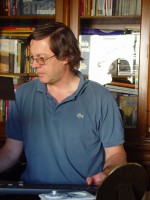resumo
We have studied the structure, microstructure, and electrochemical properties in air of (Pr-2 - Zr-x(x))Zr2O7 + (x/2) (X = 0.15, 0.32, 0.78), Pr2Zr2O7, and Pr-2(Zr-2 - Pr-x(x))O-7 - (x/2) (x = 0.1, 0.4, 1) materials. The solid solutions were prepared through coprecipitation followed by heat treatment of the precursors at 1550 degrees C for 4 h. According to XRD data, the extent of the pyrochlore-like Pr-2 xZr(2) th xO(7) th (x/2) solid solutions at 1550 degrees C is -6 mol.%, which is considerably smaller than that in the NdZrO and SmZrO systems at this temperature. Among the pyrochlores, the highest bulk conductivity was offered by the (Pr2-xZrx)Zr2O7 + x/2 (X = 0.15): 7.15 x 10-3 S/cm at 800 C (Ea= 0.66 eV).The pyrochlore-like Pr-2(Zr-2,Pr-x)O-7 x/2 (X = 0.1) had lower conductivity (3.97 x 10-3S/cm at 800 C). The highest bulk conductivity among the materials studied was found in the Pr(2)03-rich fluorite-like Pr-2(Zr-2 - Pr-x(x))O-7 - (x/2) with x = 1: similar to 0.217 S/cm at 800 degrees C (E-a = 0.0.31 eV). The temperature-dependent conductivity of the Pr2O3-rich fluorite-like solid solutions Pr-2(Zr-2 - Pr-x(x))O-7 (x/2) with x = 0.4 and 1 had a break at 560 C, suggesting a change in the mechanism of ion transport at this temperature. 2014 Elsevier B.V. All rights reserved.
palavras-chave
OXYGEN STORAGE CAPACITY; ELECTRICAL-PROPERTIES; STABILIZED ZIRCONIA; DEFECT CHEMISTRY; PRASEODYMIUM; OXIDES; CONDUCTIVITY; GENERATION; METHANE; O-2
categoria
Chemistry; Physics
autores
Belov, DA; Shlyakhtina, AV; Abrantes, JCC; Chernyak, SA; Gasymova, GA; Karyagina, OK; Shcherbakova, LG
nossos autores
agradecimentos
This work was supported by the Russian Foundation for Basic Research (grant no. 13-03-00680) and the Chemistry and Materials Science Division of the Russian Academy of Sciences (basic research program no. 2 grant no. 2 OChA: Advanced Metallic, Ceramic, Glassy, Polymeric, and Composite Materials). This work was supported in part by M.V. Lomonosov Moscow State University Program of Development.


